Day 2 of a three day, small group, socially-distanced Early Autumn Tour in Norfolk. It was mostly bright with some sunny intervals and although it clouded over for a bit around the middle of the day, the rain (which wasn’t in the forecast!) skirted round to the west and north of us. Another nice day to be out birding.
Our first destination for the morning was Stiffkey Fen. As we walked down along the permissive path beside the road, a Common Buzzard flapped up out of the copse ahead of us. As we got into the trees, a Chiffchaff was singing – not too unusual at this time of year, and possibly a young bird practicing.
There were more warblers in the trees down by the river, as we came across the back end of a mixed tit flock, Blackcaps, more Chiffchaffs and a brief Reed Warbler. Warblers will often join up with the roving tit flocks at this time of year. The flock was moving quickly through the trees and we tried to follow them. They crossed over to the Fen, where we caught them a couple of times through a gap in the vegetation and at one point we had several Long-tailed Tits feeding in one the sallows above us. A Bullfinch was piping plaintively further back.
It was quite breezy this morning, but sheltered down beside the river. There were lots of insects along here – several Speckled Woods and a smart orange Comma butterfly basking on the bushes. A couple of Migrant Hawkers were hawking back and forth across the path and one of two Common Darters were enjoying the sunshine on the vegetation.

When we got to the point on the path where you can look across to the Fen beyond, we could see a sizeable collection of large white blobs over towards the far corner. Spoonbills! The vegetation is quite tall now though, so it is hard to see clearly from here, so we continued on and up onto the seawall. There were lots of Linnets and Goldfinches on the bushes as we walked out and looked back across the Fen.
We had a much better view of the Spoonbills from here, and we could see that there was indeed still a good number of them. Most were doing what Spoonbills seem to like to do best – sleeping – but one or two were preening and a juvenile was relentlessly pursuing an adult nearby, bobbing it head up and down and demanding to be fed. It was hard to get an accurate count with so many asleep in a tight bunch, but there were at least 44 Spoonbills here and probably a few more than that.
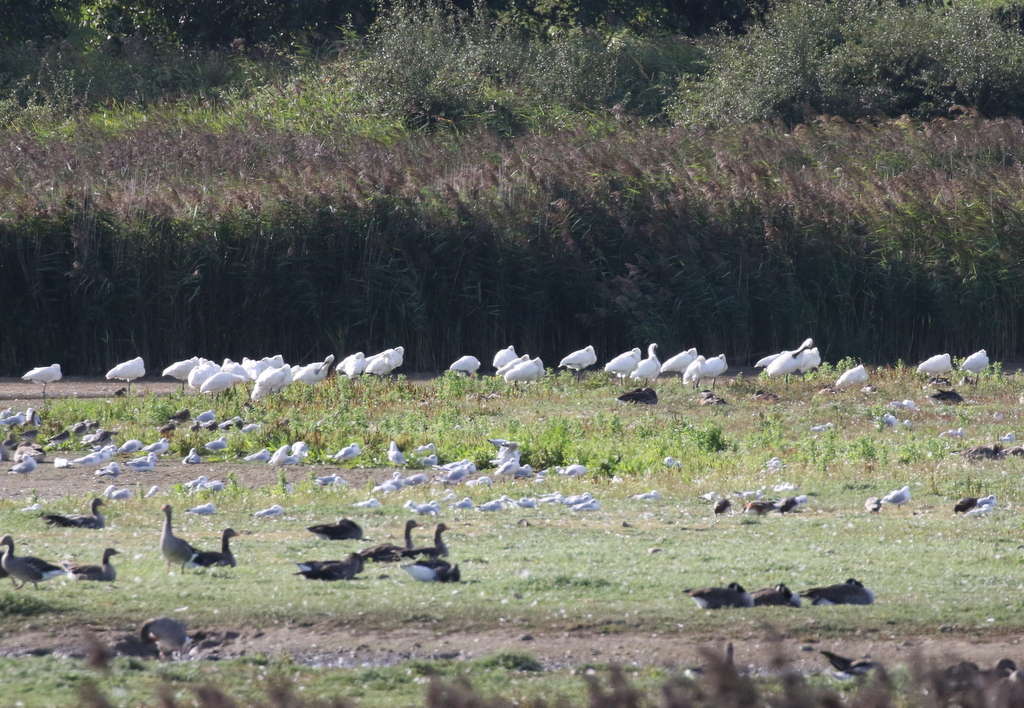
The Spoonbills gather here at the end of the breeding season, with most of the birds probably coming from the breeding colony at Holkham. It has become quite a spectacle to see them at this time of year. They will be heading off south at some point this month, so it was good to find we hadn’t missed them yet.
Close to the Spoonbills, a group of pale looking waders were roosting in the shallow water, ten Greenshanks waiting out the high tide here. There was a big flock of roosting Black-tailed Godwits on the island and a group of Common Redshanks over at the back. A scattering of Ruff were feeding on the muddy edges and scanning round the margins of the Fen, we found two Green Sandpipers. We walked a bit further up and looked back to the other side, which produced five more Greenshanks to add to the total.
There were lots of Greylag Geese on the Fen and plenty of ducks, mostly moulting Mallard, the drakes in drab eclipse plumage, but also with a few Wigeon and Teal. A small group of Shoveler were feeding, heads down, in the deeper water in the far corner.
Black-headed Gulls were coming and going, with a large group loafing on the islands and others preening in the shallow water. A single Common Gull in with them allowed a good opportunity to compare. A grey-winged male Marsh Harrier came up out of the reeds at the back and landed briefly in one of the trees.
Looking out across the harbour, the tide was in. It was a big tide today too, so the saltmarsh was flooded with just the tops of the taller bushes poking out above the water. Two Kingfishers shot across, flashing electric blue, following the course of the channel before cutting across the saltmarsh towards the harbour.
There were a few more Redshank out here, and some Curlew out here, and we could see two Knot trying to roost on one of the shingle islands in the distance. There were lots of seals hauled out on the end of Blakeney Point, and we could even hear one barking at one point.
News came through that the Wryneck had been seen again at Weybourne Camp, so we decided to head over there and have a go for that, and we thought we might possibly pick up some things over the sea at the same time. We parked at Weybourne beach and walked west along the coast path. The sea looked disappointingly quiet, but as we got almost to the small group of people gathered staring over the fence across the Camp, we did come across a single Wheatear in the short grass.
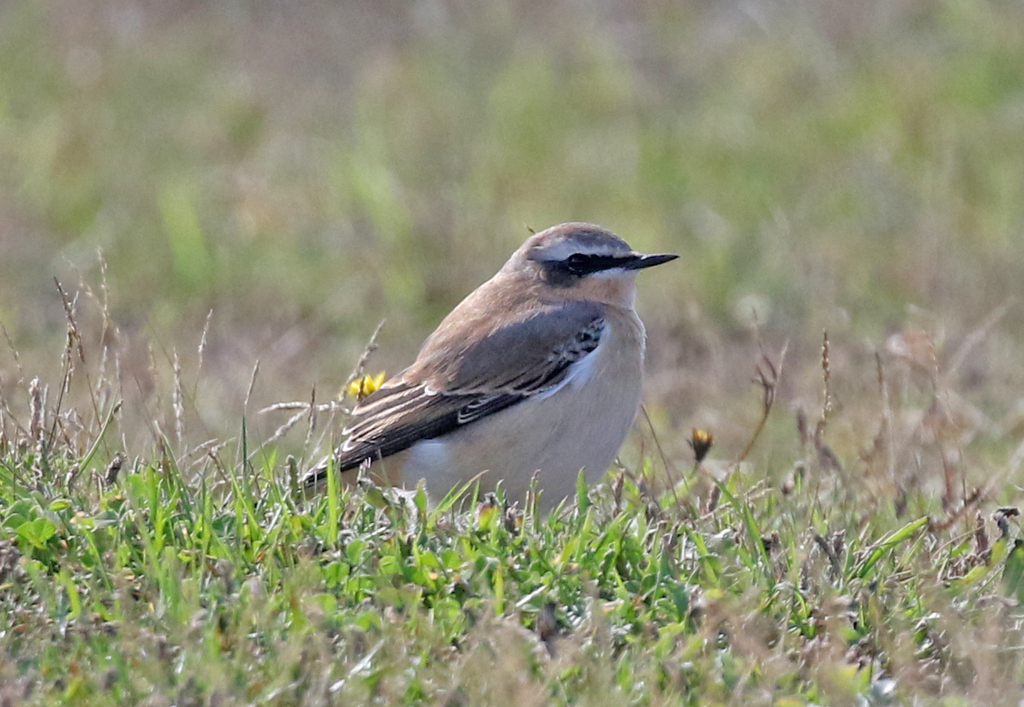
There was no sign of the Wryneck and we were told it had not been seen for the last hour, but there were lots of other birds. Several Stonechats were flitting between the bushes and the short grass, including a couple of still streaky juveniles. One or two Common Whitethroats and a Lesser Whitethroat popped up out of the brambles from time to time.
A Guillemot was pulled out on the beach, lying on the shingle some distance above the receding tide now. It looked like it might be unwell, but could perhaps have just been resting.
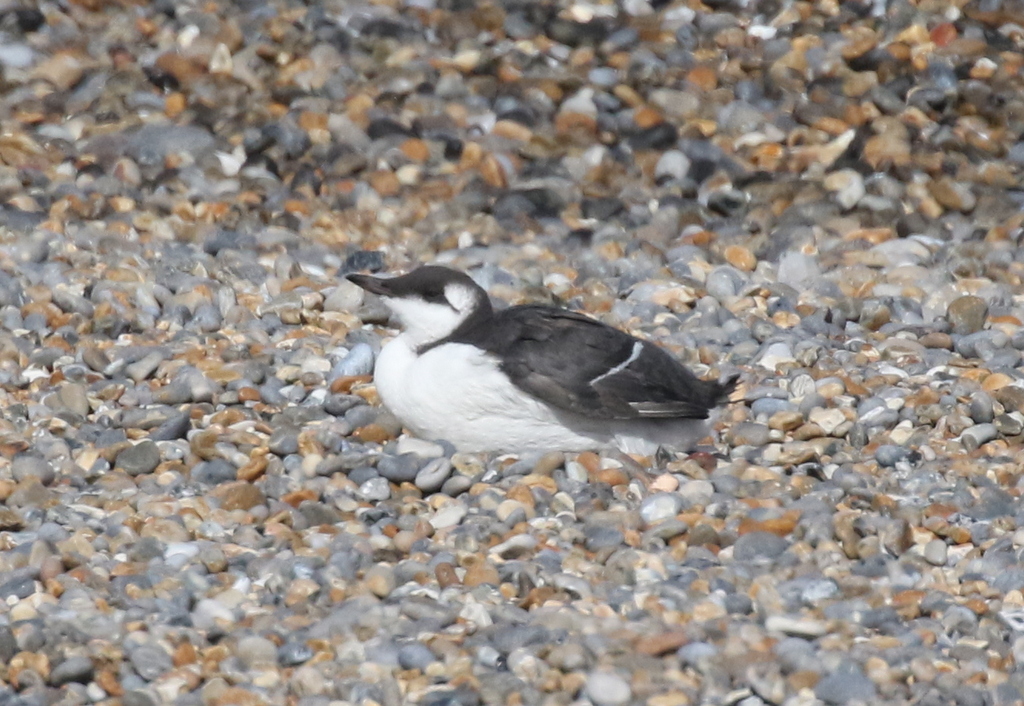
There had been a Spotted Flycatcher seen here earlier, and after a while it reappeared on the front edge of the pines, perching on a dead branch where we could get it in the scope. It kept flying off and coming back. There had apparently been a Pied Flycatcher seen on the Camp too this morning, but it is private land, fenced off with a particularly aggressive barbed wire fence, and the bird was not visible from the coast path.
Still, it all hinted that there were some migrants around today, which was supported by the Meadow Pipits which came in off the sea and or our heads, a couple of singletons and a small flock of seven, fresh arrivals coming in for the winter.
Then someone called that the Wryneck had appeared – it had flown up and was perched in some dead branches sticking out of one of the bramble clumps. We got it in one of the scopes quickly, and it stayed just long enough for most of the group to get a quick look, before it dropped down again. We waited a short while to see if it would reappear again, but it didn’t. Those who hadn’t seen it were not fussed about missing it, so we decided to move on. As we walked back along the coast path, a small flock of Knot flew past just offshore – more migrants on the move.

We drove round to the Visitor Centre at Cley to make use of the facilities and have our lunch on the picnic tables there. Scanning Pat’s Pool from the picnic area, we could see that the three juvenile Curlew Sandpipers we had seen yesterday were still present, albeit they were very distant from here.
After lunch, we could see some rather ominous dark clouds to the west and it was clearly raining offshore. It was forecast to remain dry here all day (not that this means anything!), and we figured the worst of the cloud should miss us, so we decided to head back to Kelling to walk down the lane to the coast. With some migrants around this morning, we hoped we might find something in the bushes here this afternoon.
It was rather cool in the lane with the grey cloud and the freshening breeze. There is normally a good selection of butterflies and dragonflies along here, but the only thing we came across today was a single Willow Emerald damselfly hanging on an overhanging wild rose branch. A single Chiffchaff hooeeted from the copse, but otherwise there were disappointingly few birds on the walk down.
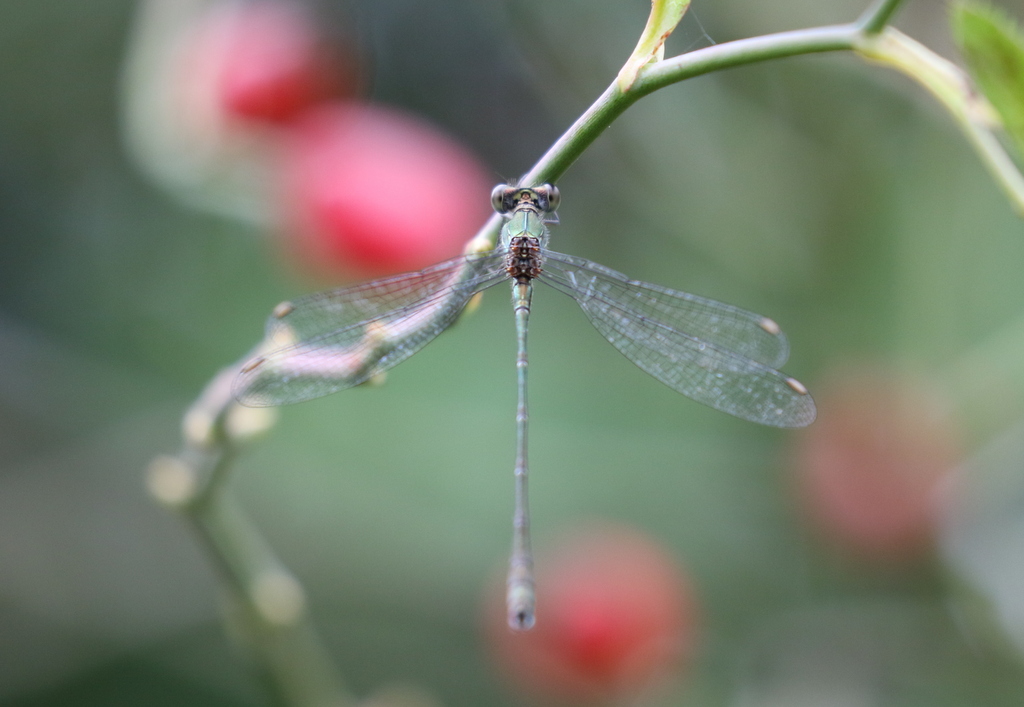
There were a few ducks on the Water Meadow – Teal, Wigeon, Mallard – and a few gulls flying in and out from the water. The best birds on here today were two Little Grebes. Three Egyptian Geese flew over and landed on the Quags as we carried on along the cross-track.
The bushes above the track to the Hard produced just a single Stonechat and there was only one Pied Wagtail out on the short grass on the Quags. We walked a short way up the permissive path towards the gun emplacements, and stopped to scan the sea. Another Stonechat was in the bushes here but we couldn’t see anything passing offshore.
It was clear there were no migrants to be found here, so we decided to head back and try something different. A Great Spotted Woodpecker flew over and landed in the top of one of the trees by the school when we got back to the minibus.
It was a bit of a drive from here down to the Brecks, but when we got there we pulled off the road to scan a large area of pig fields. Almost as soon as we got out, we could see a Stone Curlew out in the middle. They can be remarkably well camouflaged down in the bare stony ground and there is restricted visibility from here, but the more we scanned, the more we found, until we could see at least six.
One Stone Curlew was not too far out, so we got it in the scope and had a closer look, its bright yellow iris, black-tipped yellow bill and rather knobbly yellow legs all helping to give it a rather prehistoric appearance.
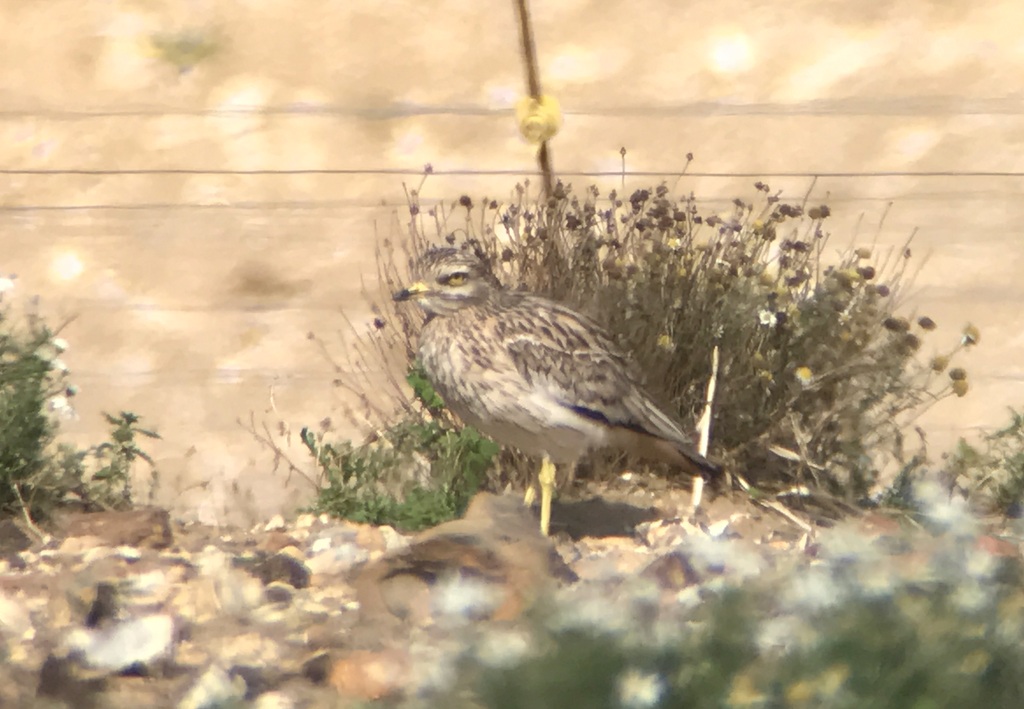
The Brecks is the most important breeding area for Stone Curlews in the UK, and they traditionally gather together at the end of the breeding season, so it is another must see sight at this time of year. There was a Wheatear feeding out in the pig field here too.
Driving on, we scanned some other fields but couldn’t see any more Stone Curlews at first. Then we stopped at another gateway and scanned the pig fields from here more distantly. They were a long way off from here, but we counted another 15 Stone Curlews giving us over 20 in total, a respectable total, particularly given there are probably only just over 200 pairs in the Brecks.
There was a huge flock of sparrows feeding in the weedy vegetation on the front edge of the pig field. It was impossible to make out any detail when they were feeding down in the vegetation, and not much easier when they weren’t given the distance and a lot of shimmer coming off the stubble field in front. But when a small group of them flew across and landed in the top of a nearby bramble bush, we could make out several Tree Sparrows in with the fifteen or so birds in view. How many might there be in the whole flock?
It was unfortunately not quite as windy here – either the wind had dropped, or it was not as strong inland as on the coast – but we decided to have a quick look to see if there were any raptors up enjoying the breeze. We stopped somewhere with a good vista looking across the forest and got out to scan over the trees. All we could see from here were just one or two Common Buzzards.
We hadn’t been here very long when one of the group saw a large black bird flying over the field away to our right. A Raven? Unfortunately, it disappeared behind the trees just as the rest of us turned to look. We walked round and scanned the sky the other side and had another glimpse of it as it appeared to drop down to the fields beyond the next hedge. It did look like a Raven, so we hopped back in the bus quickly and drove back up the road.
Sure enough, there was the Raven in the field. We got it in the scope and could see its massive bill. At one point, it was harassed by a Carrion Crow, which looked tiny next to it. It was a nice bonus to end with – Ravens are spreading east but are still scarce birds in Norfolk. With a long drive back, we unfortunately had to call it a day.
















